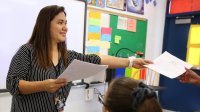Better Ways to Measure Student Progress
Distance learning has forced many educators to take a closer look at traditional grading and contemplate better methods of assessment.
Your content has been saved!
Go to My Saved Content.Following the widespread closure of schools last spring, teachers grappled with the challenges of remote learning. Meeting students’ needs became more difficult as teachers traded the predictability of in-person schooling for the unpredictable nature of learning by distance.
Many educators embraced greater flexibility and grace in measuring student progress. Broadly, schools encouraged a focus on learning and growth instead of a steadfast devotion to letter grading. Why has this not always been the case? The coronavirus pandemic has revealed many uncomfortable truths about the American educational system, and schools now have a chance to reimagine the fundamental nature of schooling in the United States.
Traditional grading practices are deeply flawed, and it’s high time to replace them with more beneficial ways of measuring student progress. Over-relying on summative assessments does little to encourage the collection and use of formative data, and even the best teacher-created assessments still confront issues of reliability and validity. While the objectivity of attaching numbers to student proficiency may seem precise, this specificity rings hollow and only serves to lower student motivation.
I am not so naive to think that American education will broadly adopt standards-based grading practices or a fundamental uncoupling of the A–F grading system, but there are steps that teachers can take now that would make a big difference.
Improving How We Assess Learning
Provide students with multiple attempts at mastery: Whether they are in elementary, middle, or high school, students deserve more than one chance to demonstrate knowledge. Despite the popularity of promoting a growth mindset in students, too many schools continue ignoring the power of “yet.” Instead of judging a student’s performance at a discrete moment in time, we should offer students the chance to improve their skills until their proficiency matches their true ability. Few of us perform at our highest level the first time we demonstrate a skill, and our students are no different.
Similarly, teachers should protect students’ agency and promote a culture of choice within assessments: While there will always be a place for end-of-unit assessments, relying on these for a complete portrait of student proficiency is an extremely limited view. Instead, students deserve the chance to demonstrate their proficiency in multiple ways across time.
Whether you call this differentiated instruction, authentic assessment, or some other concept isn’t that important. What matters is giving students choices and emboldening their self-efficacy. Not only does this style of assessment provide a rich trove of formative data for teachers; it also invites much-needed relevance into the classroom.
Finally, adopting a more holistic view of assessment has the potential to harness motivation that far outpaces anything that simple letter grades can offer: For students—and people in general—to engage in goal-directed behavior, they must have self-efficacy, perceive their environment to be supportive, and see value in their work. When these forces are present, students work longer, harder, and with more joy. Prioritizing student success over time has direct, positive implications for each of these elements.
This view of assessment also empowers students to take control of their learning instead of being casual observers of their own ability. Compare the approach of cramming for a single test with knowing you have the option to learn more and try again in the future. The former promotes anxiety and a tendency to learn and dump material. The latter encourages curiosity, reflection, and perseverance, traits we want all students to possess.
Much of what happens or doesn’t happen in a classroom occurs because of the lived experience of a teacher. As we seek to teach students, we unconsciously set limits on our students’ success by what we think is possible for them to achieve. Thus, the largest inhibitor of student success in a classroom is a teacher’s belief of what is possible for his or her students.
The pandemic has provided a generational moment for American schools to unlearn practices that hinder students’ growth and adopt beliefs that propel students forward. Teachers should revisit outdated ways of measuring and communicating performance in favor of flexible grading practices. By encouraging multiple attempts at mastery, promoting choice within assessments, and harnessing students’ true motivation, teachers have the potential to refashion the ways in which students understand performance. It won’t be as easy or as neat as stamping a letter grade on an assignment and moving on, but it’s more than worth it.
